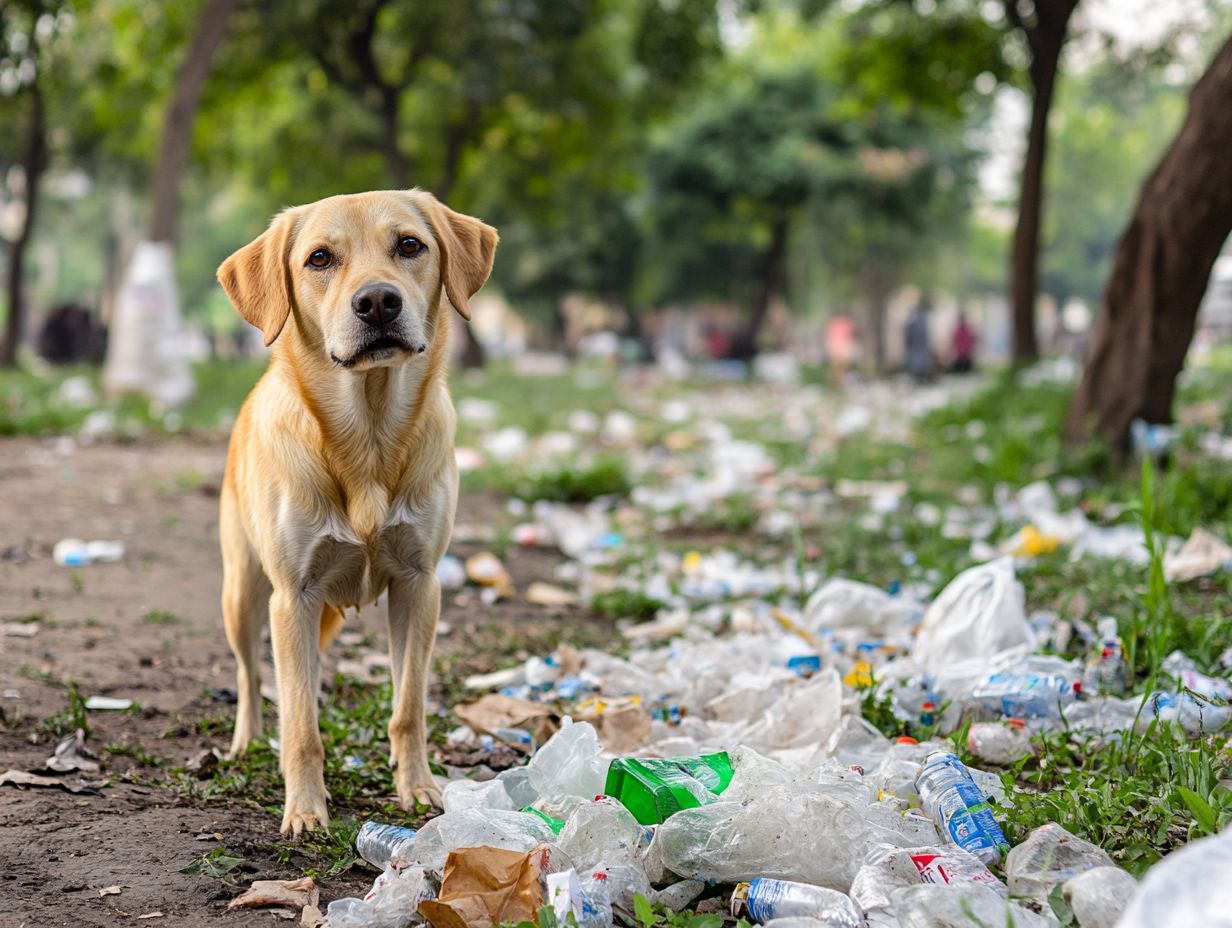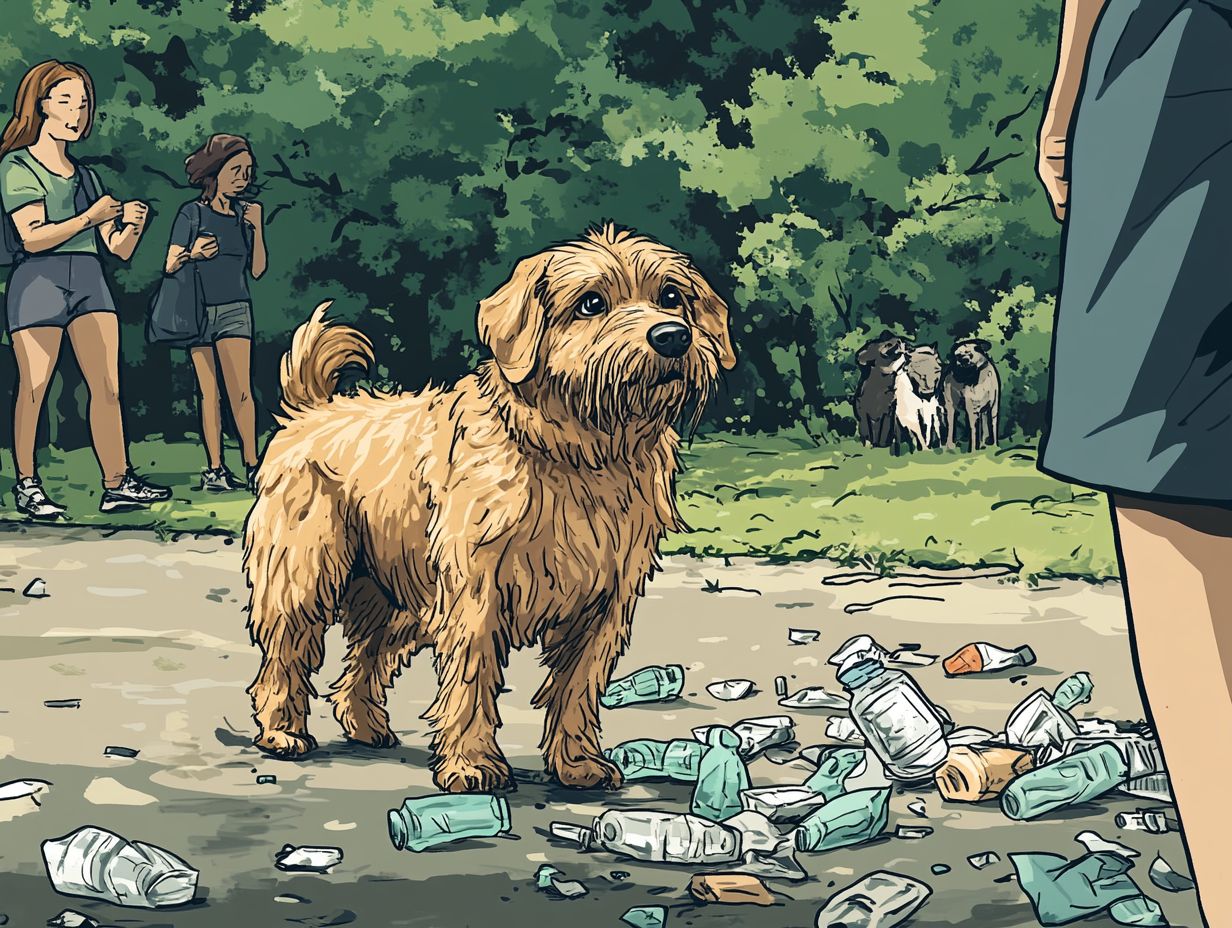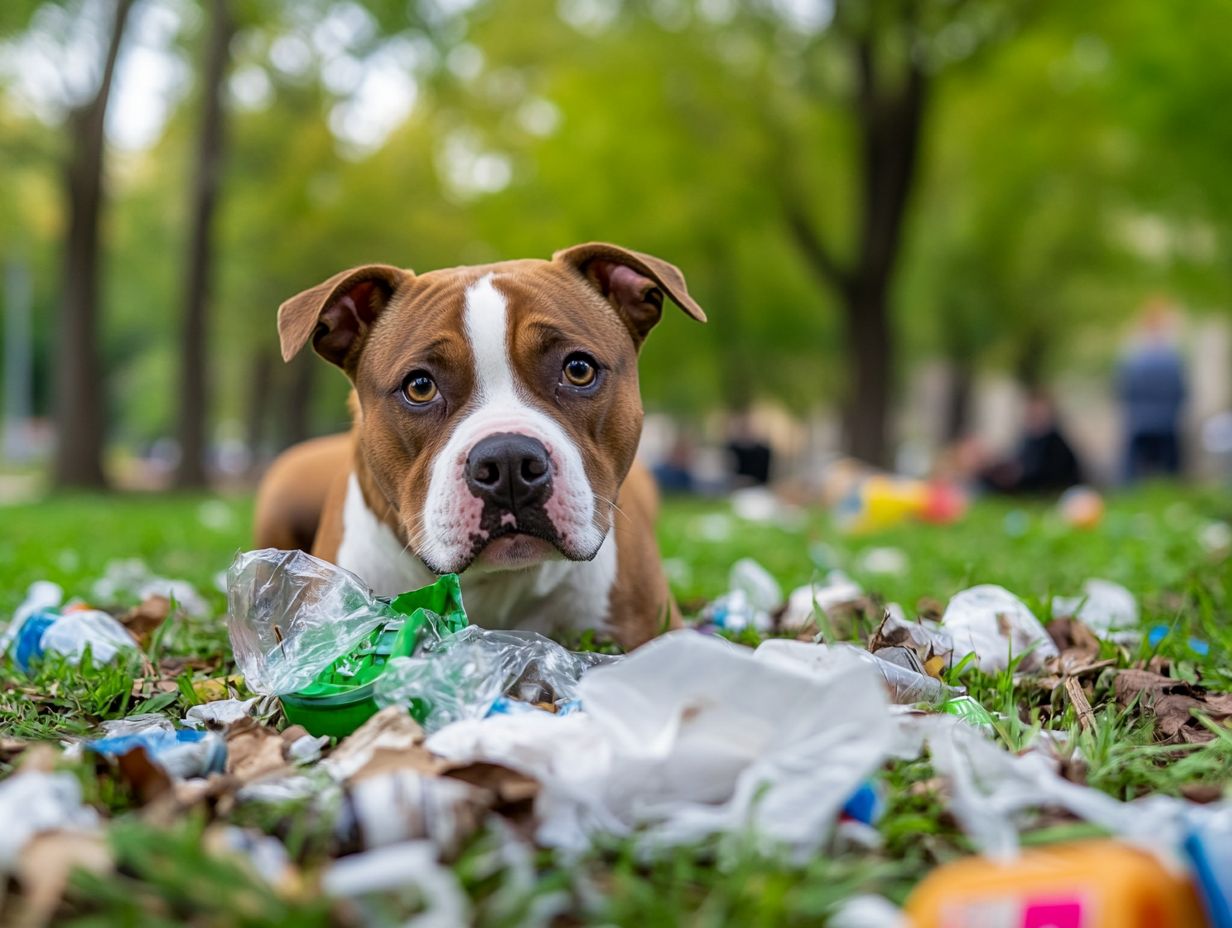Proper litter disposal is essential for protecting our environment and ensuring the well-being of local wildlife.
The materials we select, whether plastic bags or clay litter, can significantly affect the planet and its inhabitants in the long term.
This article will examine the harmful effects of common types of litter, introduce eco-friendly alternatives, and provide practical disposal methods.
Additionally, it will highlight ways to motivate your community to take action and positively impact Danville’s furry friends.
The Importance of Proper Litter Disposal

Proper litter disposal plays a vital role in maintaining a healthy environment and protecting wildlife.
With increasing concerns about environmental pollution, particularly in states such as California, it is important to understand how our waste management practices can significantly impact community health and safety.
This responsibility does not rest solely on individuals; local governments, educators, and parents also share the duty of promoting proper disposal methods.
Initiatives have highlighted the importance of addressing litter issues while fostering education and awareness.
In an era where misinformation can quickly spread through platforms like Facebook and TikTok, creating a culture of responsible litter disposal is crucial for the welfare of both animals and the environment.
Impact on the Environment
Litter significantly impacts the environment, contributing to pollution that can harm ecosystems and biodiversity.
When debris is carelessly discarded, it can infiltrate various ecosystems, leading to the contamination of water sources through runoff and creating hazardous conditions for aquatic life.
Wildlife habitats are adversely affected as animals may ingest or become entangled in this waste, resulting in injuries or, in some cases, death.
Over time, natural landscapes can lose their pristine beauty due to the unsightly presence of trash, which disrupts local flora and fauna.
By recognizing the delicate balance of these interconnected systems, it becomes increasingly evident that implementing effective environmental protection measures is essential.
Such measures are crucial for mitigating the effects of littering and preserving the health of our planet.
Impact on Animals
The presence of litter presents numerous hazards to wildlife, often leading to injury or death for animals that mistakenly ingest or become entangled in debris.
For example, sea turtles frequently mistake floating plastic bags for jellyfish, which can result in gastrointestinal blockages that may prove fatal.
Birds, on the other hand, often confuse colorful plastic fragments for food, posing serious health risks and disrupting the food chain in the process.
Terrestrial animals, such as deer and raccoons, can become trapped in discarded fishing lines or six-pack rings, leading to severe injuries or even death.
The impact of litter is also felt by domestic pets; dogs may chew on hazardous objects, putting themselves at risk of choking or poisoning.
Understanding the relationship between litter and animal safety is essential, as each piece of debris can have devastating consequences for both wildlife and our cherished pets.
Common Litter Materials and their Hazards
Different types of litter, such as plastic, clay, and biodegradable materials, each pose distinct dangers to the environment and wildlife.
In states like California, improper disposal of these materials can result in enduring ecological harm and exacerbate the ongoing pollution crisis.
It is crucial for parents, educators, and communities to understand the implications of each type of material in order to promote better environmental practices.
Given that misinformation often circulates through social media platforms like Facebook and TikTok, it becomes essential to clarify the risks associated with these types of litter to encourage responsible disposal and recycling efforts.
Plastic Litter

Plastic litter has become one of the most widespread forms of waste, significantly contributing to environmental pollution and posing serious risks to wildlife.
This material is so common that it can take hundreds of years to decompose, during which time it leaches harmful chemicals into the soil and waterways.
The environmental risks linked to plastic waste are quite concerning.
Many animals mistakenly ingest these plastic fragments, thinking they are food, which can lead to serious health issues and even death.
Moreover, the accumulation of plastics in oceans and other ecosystems disrupts natural habitats, threatening biodiversity and endangering species that are already at risk.
Addressing plastic pollution is essential, not just for maintaining the balance within our ecosystems but also for protecting the health of future generations.
Clay Litter
Clay litter, commonly used for domestic animals, can have various environmental impacts, especially when not disposed of properly.
Many pet owners value its absorbent qualities and clumping effectiveness; however, it is important to note that clay litter is primarily composed of strip-mined sodium bentonite clay, which raises significant ecological concerns.
The extraction process involved in obtaining this clay can lead to habitat destruction and the depletion of local resources, negatively affecting wildlife and surrounding ecosystems.
Once discarded, clumping clay litter usually ends up in landfills, which not only contributes to the ongoing waste crisis but also poses safety risks due to the potential leaching of harmful substances into soil and water systems.
As such, choosing alternatives that prioritize both pet care and environmental safety is becoming increasingly important for responsible pet owners.
Biodegradable Litter
Biodegradable litter is often marketed as an environmentally friendly alternative, aimed at lessening the negative impact on our surroundings.
By utilizing natural materials, this type of litter not only reduces landfill waste but also breaks down more effectively, thereby benefiting soil health.
It is designed to decompose, returning nutrients to the earth, in contrast to traditional options that can persist for years and contribute to pollution.
While biodegradable litter offers advantages such as lower toxicity and compostability, it can sometimes come with a higher price and may require specific disposal methods to ensure effective breakdown.
Understanding these benefits and limitations allows consumers to make informed choices that align with their values of sustainability and eco-friendliness.
Alternatives to Traditional Litter
Exploring alternatives to traditional litter is crucial for fostering environmental responsibility and sustainability.
As concerns about litter waste grow in communities across states like Michigan and Colorado, it becomes increasingly important to seek eco-friendly options that can change our perspectives on pet care and waste management.
Furthermore, DIY litter solutions present innovative and sustainable practices that resonate with contemporary environmental objectives.
Social media platforms such as Facebook and TikTok serve as effective channels for sharing these alternatives, motivating others to make responsible choices that contribute to creating safer, cleaner communities.
Eco-Friendly Options

Eco-friendly litter options are gaining traction among pet owners who are mindful of their environmental impact.
As awareness of sustainability issues increases, many individuals are turning to brands like World’s Best Cat Litter, which uses whole-kernel corn to produce a biodegradable product.
Others are exploring recycled paper litters, such as those provided by Yesterday’s News, which convert post-consumer paper into a sustainable alternative.
Additionally, bamboo-based litter options not only decompose naturally but are derived from a rapidly renewable resource.
These alternatives not only help reduce waste in landfills but also enhance indoor air quality, making them excellent choices for pet owners committed to minimizing their ecological footprint.
DIY Litter Solutions
DIY litter solutions present a creative approach to managing pet waste while promoting eco-friendliness and sustainability.
These homemade alternatives not only decrease the reliance on commercial products, but they also enable pet owners to tailor their litter to meet their specific needs.
For example, shredded paper, easily obtained from old documents, serves as an excellent absorbent material and is entirely biodegradable, making it a more sustainable option compared to conventional clay litters.
Another eco-friendly choice is sawdust made from untreated wood, which clumps effectively while providing excellent odor control.
By utilizing these straightforward recipes, pet owners can actively contribute to a healthier planet and minimize the environmental impact associated with traditional litter products.
Proper Litter Disposal Methods
Understanding proper disposal methods is crucial for minimizing the environmental impact of litter, especially when it comes to potentially hazardous materials.
Communities in states such as Wisconsin and Colorado are increasingly acknowledging the significance of implementing effective disposal strategies to safeguard the environment and protect wildlife.
This approach includes exploring recycling and composting options that can convert waste into valuable resources.
Given that misinformation can spread rapidly on social media platforms like TikTok and Facebook, it is essential to provide clear guidelines to help community members comprehend their responsibilities in waste management.
Recycling and Composting Options
Recycling and composting options are excellent eco-friendly alternatives for managing waste, effectively transforming litter into valuable resources.
These practices not only reduce the amount of waste sent to landfills but also promote a sustainable environment by conserving natural resources and decreasing pollution levels.
When individuals and communities recycle materials such as paper, plastics, and metals, they can significantly lessen their carbon footprint.
Composting, in contrast, takes organic waste—like food scraps and yard debris—and turns it into nutrient-rich soil.
This process enriches both gardens and agricultural lands while also reducing reliance on chemical fertilizers.
By embracing these methods, communities can enhance engagement and awareness around responsible waste management, ultimately fostering a culture of sustainability.
Disposing of Hazardous Litter

Disposing of hazardous waste requires careful consideration to ensure both safety and environmental protection.
This category includes various materials, such as batteries, chemicals, and electronic waste, all of which present considerable risks to human health and the surrounding ecosystem.
It is essential for individuals and communities to understand that improper disposal of such waste can result in soil and water contamination.
To manage these hazards responsibly, it is advisable to use designated drop-off locations or participate in municipal collection days specifically organized for toxic materials.
Participating in recycling programs and adhering to local guidelines not only enhances safety but also promotes greater environmental awareness.
This approach underscores how our collective actions can significantly contribute to a healthier planet.
How to Encourage Proper Litter Disposal in Your Community
Encouraging responsible litter disposal in your community requires a comprehensive approach that emphasizes education, awareness, and active participation.
As concerns about litter management grow in states like California, it becomes crucial for communities to engage parents, educators, and local organizations to cultivate a culture of responsibility.
Utilizing social media platforms such as Facebook and TikTok can significantly broaden the reach of awareness campaigns, motivating individuals to take action.
Furthermore, implementing community programs can deepen understanding and promote safe practices for litter disposal, fostering a sense of collective responsibility and environmental stewardship.
Education and Awareness on Proper Litter Disposal
Education and awareness are crucial in promoting responsible litter disposal, as they give the power to individuals to make informed choices.
Various educational programs and community initiatives play a significant role in fostering a sense of environmental responsibility among citizens.
For instance, local schools often conduct workshops that engage students in interactive discussions about the impacts of litter on ecosystems and wildlife.
This approach effectively encourages the development of sustainable habits from a young age.
Similarly, community clean-up events not only enhance the beauty of neighborhoods but also provide valuable, hands-on lessons in waste management.
By collaborating with environmental organizations, these initiatives improve understanding of proper disposal methods and inspire participants to become ambassadors for cleaner, greener spaces.
Ultimately, this collective effort contributes to shaping a more conscientious and environmentally aware community.
Organizing Community Clean-up Events for Proper Litter Disposal
Organizing community clean-up events presents a wonderful opportunity to engage residents in responsible litter disposal and environmental stewardship.
These initiatives not only promote a sense of unity among participants but also foster a deeper appreciation for local natural spaces.
To ensure the success of these events, it is vital to involve a diverse range of community members, including schools, local businesses, and non-profit organizations.
By collaborating with various groups, one can enhance participation and raise awareness about the importance of maintaining clean neighborhoods.
Additionally, promoting the event through social media platforms and community boards can attract more volunteers, amplifying the overall impact.
Ultimately, these clean-up events provide an excellent platform for education, encouraging sustainable practices that extend well beyond the event itself.
